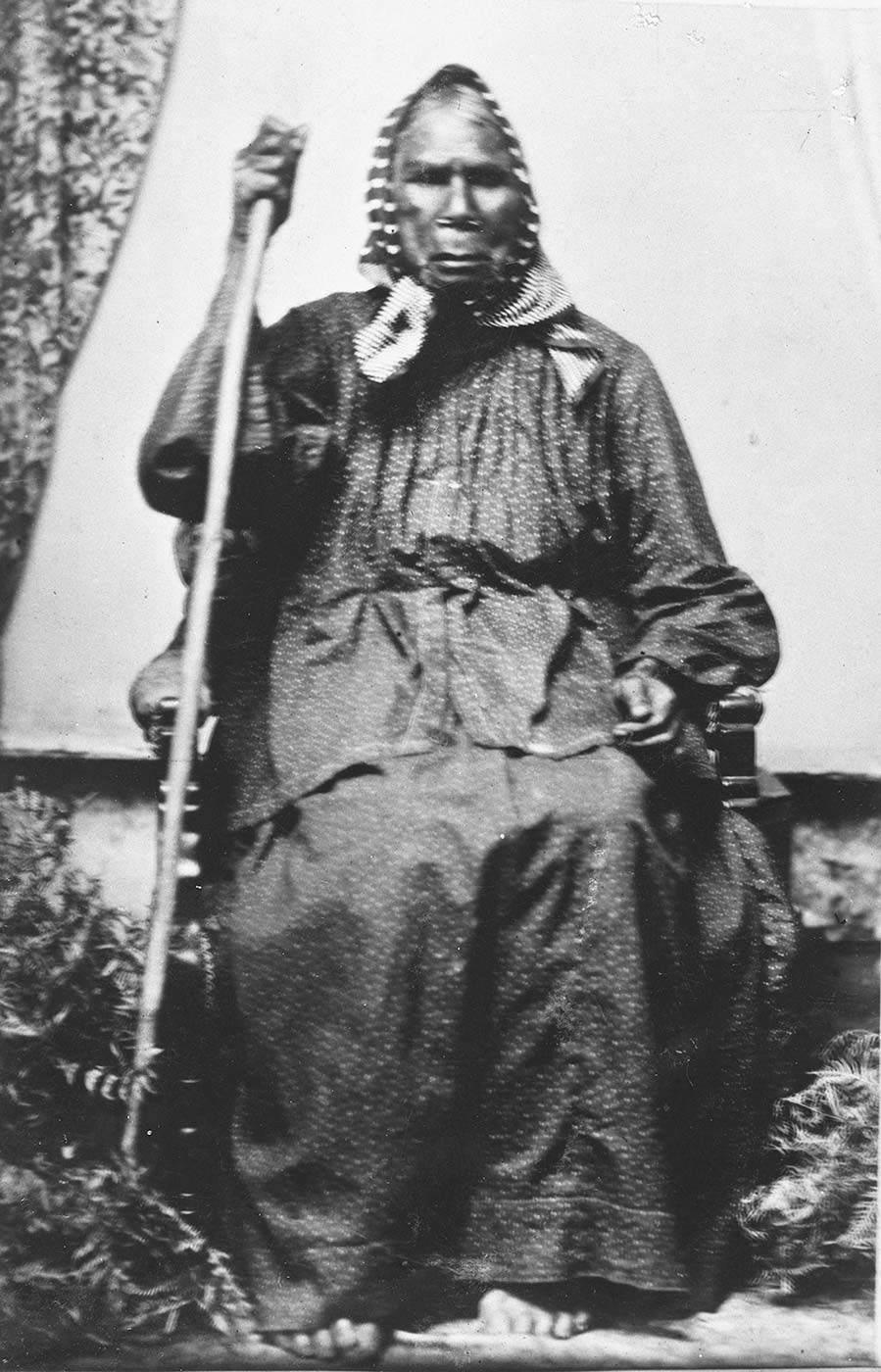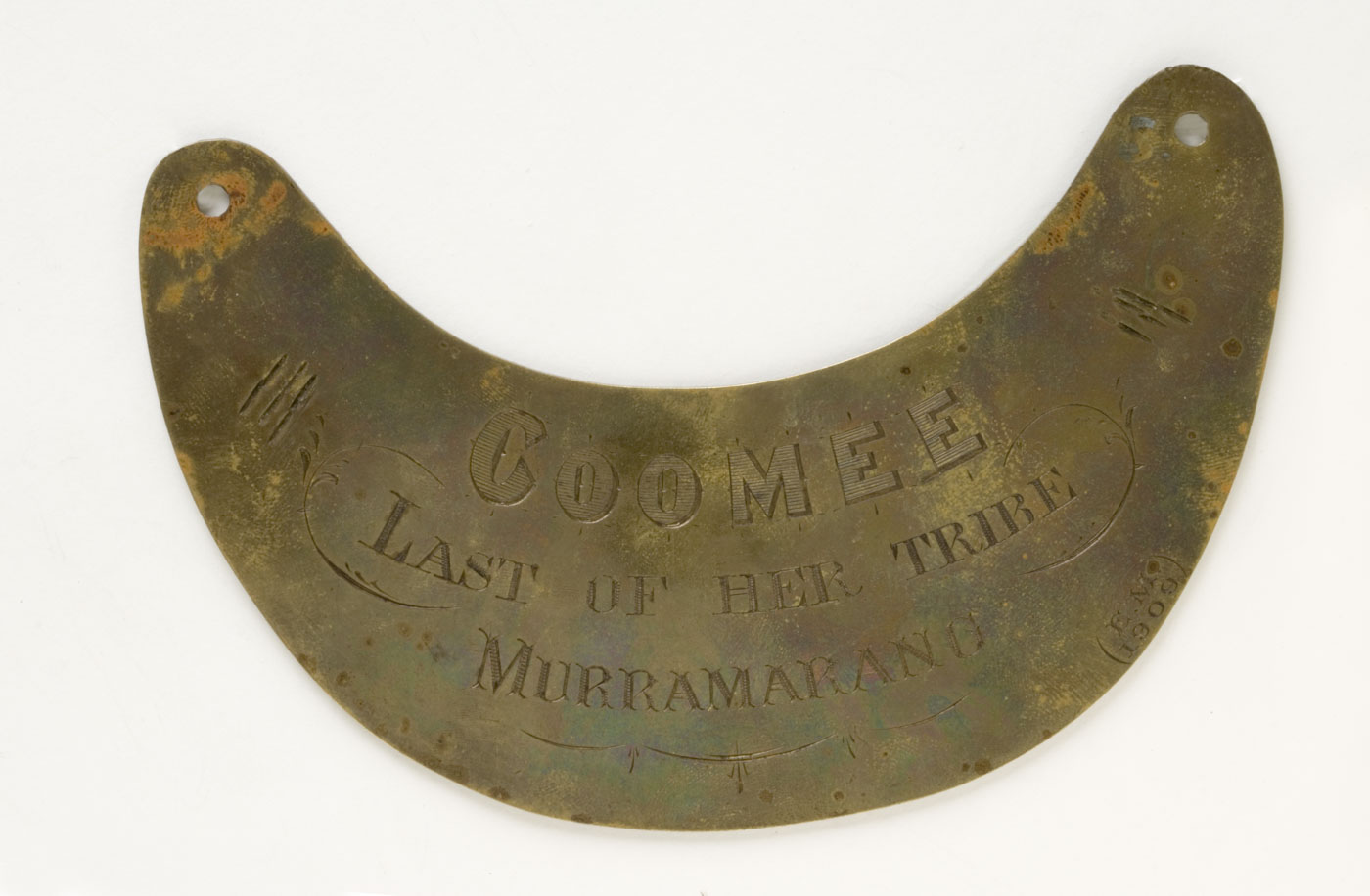Honours for the ‘Last of the Tribe’
As the 19th century wore on, people came to think that the Aboriginal population was a ‘dying race’. This notion was fuelled by ‘social Darwinism’ which was a view held by many scientists that so-called ‘primitive’ people, such as Aboriginal people, declined when in contact with ‘modern’ people such as the British settlers. The changes in Aboriginal communities were considered by many non-Aboriginal people as signals of the demise of the Aboriginal population.
As the threat from Aboriginal opposition to settlement dwindled, a nostalgia developed among the colonial population for Aboriginal traditions. This led to a notion that only Aboriginal people who had led a pre-colonial lifestyle were truly Aboriginal and the search began for the ‘last of the tribes’. In the late 19th century a number of gorgets were given to people who were considered, by non-Aboriginal people, to be the last living member of a particular ‘tribe’.
A tragic aspect of the contact between the whites and the natives in Australia is revealed by the plates given, as many of them were, to the last living member of a tribe — they thus represent the final act in the struggle for survival of our native tribes in those localities. [1]

'Coomee, Last of her Tribe Murramarang'
The National Museum of Australia has one of these memorial gorgets (collection number 1985.0059.0374).
It was presented by the avid gorget collector Edmund Milne to Coomee, also known as Old Maria and Coomee Nulunga, an Aboriginal woman he had known since childhood. [2] She was the last of the Murramarang people in her own and Milne’s eyes. However, there is a still a thriving community of south coast Aboriginal people.
To Milne, Coomee was a relic to be cherished like the other artefacts of Aboriginal Australia which he had collected. He had her gorget inscribed ‘Coomee, Last of her Tribe Murramarang’.
Milne’s gorget was a reward to Coomee for her role as the last matriarch of her people and he wrote an article in praise of her Aboriginality.
He even had her body scars reproduced on her gorget as proof positive of her status as a traditional Aboriginal person.
The notes accompanying the gorget state:
‘Coomee, last of her tribe, Murramarang’. Presented to ‘Coomee’ by Mr. Edmund Milne in 1909. He had first become acquainted with ‘Coomee’ about 1868 when a boy attending school at Ulladulla. In those days it was stated by her that she remembered her grandmother speaking of ‘the first time the white birds came by’, in allusion to the sailing ships of Capt. Cook or the First Fleet.
‘Coomee’ was over 90 years of age at her death in 1915, which would fix her date of birth at earlier than 1825, so that it is quite within reason to assume that her grandmother would be among the native people who witnessed the passage of Captain Cook along the coast of New Holland in 1772. It was in recognition of this important historical association as well as her being the last survivor of the local tribe, that Mr Milne provided this brass plate for the old woman, which on her death came back into his possession. [3]
In Dickensian style Milne described Coomee as a survivor of harsh social conditions and a financially deprived lifestyle:
Ulladulla Harbour lies some twenty miles north of Murramarang. Standing on a sheltered knoll on the inner rim of the southern point is a little, rudely built cabin. Sitting on a primitive makeshift bench fronting the blue waters is an old, old woman — an aboriginal woman. The grim, hard, weather-beaten face with its deep-set twinkling eyes, belies the shrunken, bent frame. It is a picture of a strong will and stronger vital force battling against increasing years and senile debility. Such is Coommee-Nulanga, the last survivor of the Murramurang camp — the last of her tribe. The strong, harsh features with their deeply graven lines still soften in response to a kindly word. [4]
Coomee's account of colonisation
Some of Coomee’s personality emerges in the transcription Milne provided of her statement on her life and expectations. Coomee’s account of the colonisation of her country was pragmatic and realistic. Her words made it clear that Aboriginal people were dying because colonists showed no collective concern for their welfare.
Coomee attributed the high mortality rate amongst the Aboriginal people with whom she had grown up to the denial of access to healthy ‘native food’ and an active, meaningful lifestyle and its replacement with unhealthy ‘white man tucker’, alcohol and a sedentary, purposeless existence.
Where my people? — a pause — dead all dead — Coommee soon die too — then all gone. ... Why my people die? Wha’ for you wanter know? ... Me tell you. Long tam ago me lil’ picaninny, pblenty black feller sit down longa big camp. Him eat native food all same like old wild myall feller; him fat — what you call big, strong; him skin shiny, native food good, ver’ good. You white feller come ’long — sit down — black feller him try lib it all same white feller; wear um clothes — eat white man tucker — drink white feller grog all tam he get him; lay ‘bout camp; no clim’ oller tree look for ’possum. Him skin get hard, what you call dry up; him get pblenty sick — tumble down — soon die — grog kill ‘em ver’ quick — ver’ soon — all — die — me see’um never — no more. [5]
Footnotes
[1] FD McCarthy, ‘Breast-plates: the Blackfellows’ Reward’, The Australian Museum Magazine, 1952, vol. 10, p. 327.
[2] Anon, The Milne Anthropological Collection, manuscript, National Museum of Australia, EO Milne Collection file no. 85/310 folios 198–200, nd.
[3] E Milne Jr, Health Museum Breast Plates, list, manuscript, National Museum of Australia, EO Milne Collection file no 35/310, folio 165, nd.
[4] EO Milne, ‘The passing of the lithic people: a story of the coming of white wings to Australia’, Life, 1 April 1916, p. 303.
[5] EO Milne, ‘The passing of the lithic people: a story of the coming of white wings to Australia’, Life, 1 April 1916, p. 303.
